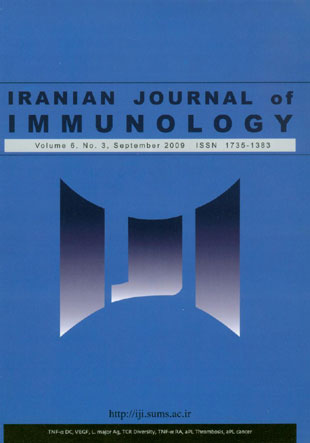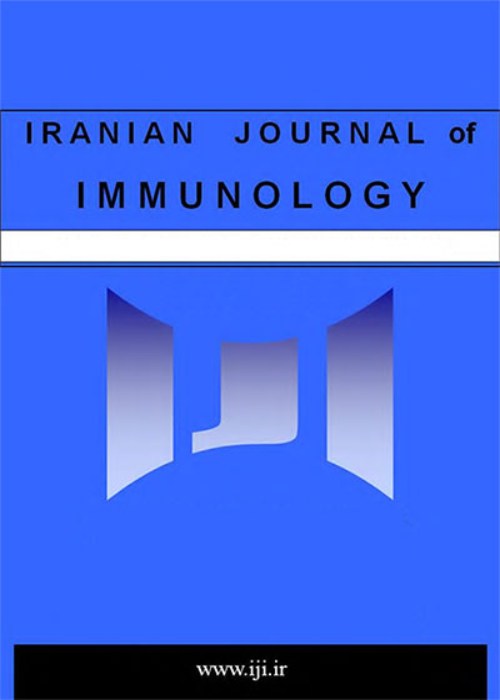فهرست مطالب

Iranian journal of immunology
Volume:6 Issue: 3, Summer 2009
- تاریخ انتشار: 1388/06/11
- تعداد عناوین: 7
-
-
Pages 107-118Background
Tumor necrosis factor alpha (TNF-α) is a primary mediator of immune regulation and might be required in the early stages of DC development from CD34+ cells. However, details of optimal timing of exposure to TNF-α in DC development process in monocytes or non-purified hematopoitic cells are still lacking and clear benefits of this approach to the development of DCs remain to be validated.
ObjectiveTo evaluate the effect of early and late exposure to TNF-α on DC development from non-purified cord blood mononuclear cells.
MethodsTo define the effects of early exposure to TNF-α on cord blood mononuclear cells, we cultured UCB-MNC in the presence of SCF, Flt3L, GM-CSF and IL-4 for 14 days and matured them for an extra 4 days. TNF-α was added on day 0, 7 and 14 in TNF-α + group, and only on day 14 in TNF-α - group where it was used only as a maturation factor.
ResultsImmediate exposure to TNF-α was shown to: (1) enhance the survival of cells in the first week of culture; (2) produce mature DCs with higher maturation markers (CD80, CD83, CD86 and HLA-DR); and (3) increase secretion of IL-12 by mature DCs. In contrast, delayed exposure to TNF-α stimulate mature DCs with less purity producing a high level of IL-10 and a low level of IL-12.
ConclusionWe developed a simple, easy and cost effective method to generate DCs from non-fractionating mononuclear cells in this study. Also we confirm the presence of a large number of functional DCs under inflammatory conditions, where local concentrations of TNF-α were high.
-
Pages 119-129BackgroundVascular endothelial growth factor (VEGF) has a key role in angiogenesis and in transplantation. The level of VEGF is related to the differences in the DNA sequence of its promoter region.ObjectivesIn this study, the association between the combination of VEGF –1154 G and –2578 C alleles and VEGF production by LPS-stimulated PBMCs was investigated. In addition; the relationship between VEGF polymorphisms and the influence of TNF-α and IL-4 on VEGF production was studied.MethodsVEGF –1154 G/A and –2578 C/A were detected using ARMS-PCR. To determine the impact of combinations of these two polymorphisms on VEGF production; PBMCs were stimulated by LPS and VEGF production was measured by ELISA.ResultsThe combinations of –1154 GG/-2578 CC and –1154 GG/-2578 CA were significantly associated with higher VEGF production (p<0.0001). Production of VEGF was significantly influenced by TNF-α in individuals who had certain VEGF genotype combinations. Although VEGF production was dramatically suppressed by IL-4, it was not dependent on VEGF genotype.ConclusionsSince TNF-α has influence on the graft outcome, to avoid allocation of grafts from high TNF-α producer donors to recipients, it might be useful to predict and minimize graft rejection by having prior knowledge of TNF-α and also VEGF genotypes especially -1154 G/A and -2578 C/A VEGF.
-
Cloning and Expression of Leishmania major Superoxide Dismutase B1:A Potential Target Antigen for Serodiagnosis of LeishmaniasisPages 130-140BackgroundLeishmaniasis- a neglected public health problem- is a group of diseases affecting an estimated 12 million people worldwide.ObjectiveIn the present study, recombinant Leishmania major superoxide dismutase B1 (rLmSODB1) has been utilized as a potential antigen for the serodiagnosis of human cutaneous (CL) and visceral leishmaniasis (VL) in the endemic regions of southern part of Iran. Additionally, the sensitivity and specificity of ELISA-based serodiagnosis using rLmSODB1 and the soluble Leishmania antigen (SLA) were compared.MethodsFor the first time, rLmSODB1 has been cloned successfully and used for ELISA-based serodiagnosis. Sera from 30 CL and 24 VL cases were included in this study. Additional studies were also done for the evaluation of cross-reactivity using sera from 41 endemic controls including normal endemic donors (n= 20), systemic lupus erythematosus patients (n=5), rheumatoid arthritis patients (n= 5), and patients with tuberculosis (n=11).ResultsAnalysis indicated that rLmSODB1 was recognized by 62.5% and 13.3% of sera from patients with VL and CL, showing a sensitivity of 72.7% and 53.6%, respectively. However 95.8% of VL and 30% of CL sera reacted with SLA, revealing sensitivities of 96% and 58.8%, respectively. Additionally, from 41 sera collected either from healthy subjects or patients affected with other diseases, 97.5% were negative with SLA or rLmSODB1 (specificity 97.6%).ConclusionThese results show that rLmSODB1 almost does not react with sera from patients with tuberculosis and autoimmune diseases and may be considered as a candidate antigen for the specific immunodiagnosis of visceral leishmaniasis.
-
Pages 141-146BackgroundPrecursor B-Acute Lymphoblastic Leukemia (precursor B-ALL) occurs due to the uncontrolled proliferation of B-lymphoid precursors arrested at a particular stage of B-cell development. Precursor-B-ALL is classified mainly into pro-B-ALL, common-ALL and pre-B-ALL. The Common Acute Lymphoblastic Antigen CD10 is the marker for common-ALL.ObjectiveThis study was aimed to examine the diversity of T-cell receptor Gamma (TCRG) and T-cell receptor Delta (TCRD) gene rearrangements in South Indian Common-ALL patients.MethodsClonality of TCRG and TCRD was studied in 52 cases (pediatric=41 and adolescents and young adults=11) of common-ALL. TCRG and TCRD gene rearrangements were amplified by PCR and the clonality was assessed by Heteroduplex analysis of amplified products.ResultsIn pediatric common-ALL, clonal TCRG and TCRD gene rearrangements were detected in 19 (46.3%) and 18 (43.9%) cases respectively. In adolescents and young adults (AYA), TCRG was rearranged in 8 (72.7%) cases and TCRD was rearranged in 4 (36.3%) cases. In the present study of common-ALL, the frequency of a TCRG rearrangement VγII-Jγ1.3/2.3 was significantly high in AYA compared to pediatric (36.3% vs 4.8%; p<0.025). Thus, VγII-Jγ1.3/2.3 was highly diverse in AYA compared to pediatric. That shows the difference in biology of the disease between pediatric and AYA in South Indian population.ConclusionThe reason for the high frequency of VγII-Jγ1.3/2.3 in AYA of common-ALL in South Indian population in connection with unknown infectious agents or environmental carcinogens needs to be evaluated further.
-
Pages 147-153Background
Rheumatoid arthritis (RA) is a chronic multisystem autoimmune disease common in all races and ethnics. Cytokines and cytokines receptors play an important role in RA pathogenesis and clinical presentation.
ObjectiveTo investigate the serum levels of TNF-α, TNF-α RI, TNF-α RII and IL-12 in RA patients and healthy control group.
MethodsIn this study 43 patients fulfilling the revised criteria of American College of Rheumatology (ACR) for RA and 13 healthy cases as a control group were selected for TNF-α, TNF-αRI, TNF-αRII and IL-12 serum level analysis. The patients'' age was 42.2 ± 22 and the age of healthy group was 40.1 ± 19.2 years (p=0.1). The patients had an active disease with at least six swollen and ten tender joints. Minimum ESR was 28 mm at first hours of the morning. Early morning stiffness in patients lasted longer than 45 minutes.
ResultsOur study showed that IL-12 serum level of the patients (91.69 ± 43.07 ρg/ml) and control (61.79 ± 40.08 ρg/ml) group was significantly different (p<0.001). The serum level of TNF-αRI was 2.36 ± 0.77 ng/ml in the patient and 1.73 ± 0.37 ng/ml in the control group (p<0.01). TNF-αRII serum concentration in patients was 8.89 ± 2.3 ng/ml, while that of control group was 7.06±1.30 ng/ml (p=0.03). The serum level of TNF-α in patients was 32.90 ± 19.27 ρg/ml and that of the control group was 24.27± 8.28 ρg/ml (p=0.08) with no significant difference between the two.
ConclusionsIt is concluded that IL-12, TNF-αRI and TNF- αRII serum concentrations are more important and better predictive factors than TNF-α in RA course and in the active forms of the disease.
-
Pages 154-159BackgroundAntiphospholipid antibodies (aPL) are a heterogeneous family of antibodies associated with thrombosis and other complications.ObjectiveTo study the prevalence of aPL in patients with thrombosis at Aleppo University Hospitals, Syria.MethodsOne hundred and fifty-seven patients with venous and arterial thrombosis and 63 healthy controls were studied. Anticardiolipin antibodies (aCL) and Lupus anticoagulant (LA) were determined.ResultsThirty-four out of 157 (21.7%) patients with thrombosis had some type of aPL. aPL was also found in four healthy subjects (4/63=6.3%). Eighteen patients (11.5%) were positive for LA, 20 (12.7%) for aCL antibodies and 4 (2.6%) were positive for more than one aPL. Patients without risk factors for thrombosis and having positive aPL were 23/34 (67.7%). Fourteen out of 78 (17.9%) patients with arterial thrombosis, and 20/79 (25.3%) with venous thrombosis were positive for at least one aPL.ConclusionOur study showed a significant prevalence of aPL in patients with thrombosis. It seems that aPL is a risk factor for venous and arterial thrombosis, especially in patients with no conventional risk factors.


